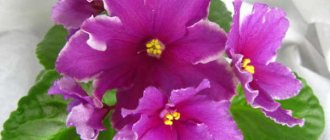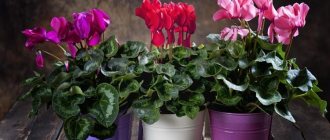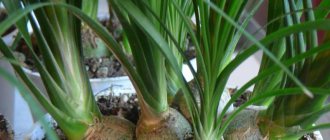Eustoma is known to us under another name as the Irish rose. This crop is suitable for growing both in greenhouses and indoors.
Eustoma inflorescences are similar in shape to roses and are good in bouquets. You can be convinced of this by looking at a photo of perennial eustoma.
Features of caring for eustoma
The process of growing and caring for lisianthus is not easy, since the plant requires diffused bright lighting and fresh air. When growing at home, it is better to place the pot with the plant on an east or west window. It is important to maintain the temperature within 19-22 ºC with frequent ventilation. Regular watering with soft, settled water is also required, the main thing is to prevent the soil from drying out and becoming overly moist. It is prohibited to spray foliage as this will lead to diseases.
Garden eustoma grandiflorum (Eustoma Grandiflorum)
As the name suggests, this crop is grown as a garden plant. The flower is quite tall, similar in appearance to a rose, and is used for cutting and making bouquets.
Let us describe the popular varieties of large-flowered garden eustoma:
The Aurora variety of double lisianthus reaches 1.2 meters in height. Inflorescences of white, blue and pink shades. The peculiarity of the flower in question is the early formation of buds; it blooms two weeks earlier than the others.
Variety Echo with spreading thick stems up to 70 centimeters in height. It blooms early, forms large inflorescences, the petals have 11 different shades.
Heidi variety.
Variety Eustoma Flamenco.
Variety Heidi . A medium-height species with simple, numerous inflorescences, it comes in 15 different color combinations. The height of the bush does not exceed 90 centimeters.
Variety Eustoma Flamenco up to 1.2 meters in height. The culture has powerful, well-developed stems and simple but large inflorescences, their diameter reaches 8 centimeters. The main advantage of Flamenco is its low maintenance requirements.
Variety Variety Twinkie.
Variety Double White.
Variety Twinkie variety with simple inflorescences. Bushes up to 50 centimeters in height with pink, purple and yellow petals.
Variety Double White . A terry type with white inflorescences, a bush up to 70 centimeters in height, with powerful, erect shoots. It is low maintenance.
Step-by-step instructions on how to grow eustoma from seeds
Growing lisianthus from seeds is a rather painstaking process that requires a lot of attention from the grower. To grow eustoma flowers from seeds yourself, you need to follow the following instructions.
- To perform this procedure, you will need a plastic tray and a metal grill with small windows. The size of the grid should ensure that the peat tablets are kept above the water.
- Initially, you need to pour water into the pan with the addition of a growth stimulator. You will also need to add other fertilizers, in particular nitrogen. It is recommended to add soil disinfectants to the water.
- Next, a grid with peat tablets is installed above the pan. They should barely touch the surface of the water. In this case, the tablets need to be spaced from each other at a distance of 5 centimeters. This will avoid fungal infection between seedlings.
- After the tablets swell from moisture, you need to place eustoma seeds in them. 3 seeds are planted in each peat tablet.
- The first shoots will appear 2 weeks after planting. At this time, you need to select the most developed and strong shoots. All sick and weak ones should be removed.
- It is important to place the tray with the trellis and plants in a warm room with moderate diffused lighting. The top of the tray is covered with glass or film to create optimal humidity conditions.
- It is necessary to ventilate the seedlings daily, without temperature changes or drafts. If the peat tablets dry out, it is recommended to carry out additional watering.
- After 5.6 leaves appear on the young plants, the cover can be removed from the tray.
- Next, transplant the eustoma along with the peat tablet into its own flowerpot. The transplantation process should be carried out in the evening.
eustoma seedlings
Russell's potted eustoma (Eustoma Russelianus)
This flower has a small compact bush, its height rarely exceeds 30 centimeters. Let's get acquainted with the most popular varieties of potted eustoma:
Mermaid variety. Lisianthus Little Bell.
The Mermaid variety has simple inflorescences up to 6 centimeters in diameter. The petals are pink-lilac or blue, the maximum height of the crop is 15 centimeters. The bush develops well and does not need pinching to form additional side shoots.
Lisianthus Light Bell is up to 15 centimeters tall with small simple inflorescences of different colors. The culture bushes well and does not require pinching of shoots.
Variety Fidelity.
Florida Pink variety.
Variety Fidelity is a beautiful flower with many white inflorescences. A feature of the culture is the spiral arrangement of peduncles.
The Florida Pink variety is a fairly compact bush up to 20 centimeters in height. The inflorescences are pink with simple petals that form a beautiful bouquet.
Rozzi variety. Variety Sapphire.
The Rozzi variety is one of the tallest crops of the species in question, its height reaches 30 centimeters. Double inflorescences with white, blue or pink petals.
Variety Sapphire with simple or double petals. The inflorescences have different colors, the height of the bush reaches 30 centimeters.
Variety Echo. Variety Aurora.
In what situations is a transplant needed?
The process of planting and transplanting eustomas is extremely painful and cannot take root in a new pot for a long time. Moreover, at home, these flowers do not grow for long - about two years, so the transplantation process is not advisable. Still, a transplant is needed:
- When buying a young plant at a flower shop. Lisianthus must be replanted within three days after purchase.
- In the case when the root system has completely filled the space of the pot. This happens extremely rarely and is typical for adult plants.
- In case the seeds were planted not in peat tablets, but in a common container.
In any of the options, you need to remember that the transplant must take place together with the mother lump of earth from the previous place of growth.
Lisianthus series and varieties: descriptions with photos
Selection work with lisianthus has not stopped to this day. New series are constantly appearing, within which a wide range of varieties of various types and colors is presented.
Varietal series are divided into two large groups:
- tall - reaching a height of up to a meter or even more, planted in open ground for cutting;
- low-growing - compact varieties, perfect for growing at home on a windowsill.
The difference exists not only in the size of adult plants, but also in the shades of the petals; within each group there are plants with double and simple flowers. Most of the seed material comes from the USA and Japan. So far, breeders have not been able to breed climbing eustoma. Under the guise of a climbing lisianthus, the gardener will, at best, get a climbing or park rose.
Tall
ABC F1 is a series of double annual lisianthus. The height of the stems reaches 75–100 cm, the inflorescences are large, 5–6 cm in diameter. Series varieties: Blue border, Blue haze, Blue blush.
Kyoto F1 - this series represents a selection of tall (up to 90 cm) varieties with simple, non-double flowers, early flowering. Representatives of this series: Picot Wine Red, Picot Pink, Picot Blue, White Kyoto.
Photo gallery: eustoma series ABC and Kyoto
The Blue Border variety looks unusual and attractive
The Blue Haze variety is named for the smooth transition of colors in color.
The Blue Blush variety is distinguished by a gentle transition from light to rich tones
Kyoto White is the most common in the series
Echo F1 is another series of tall eustoma, bred by Japanese scientists, with stems up to 70 cm long, simple flowers, classified as annuals. Bouquets of plants on tall, strong stems look great as cut flowers.
Photo gallery: Echo series for open ground
Flowers of the Echo Yellow variety are painted in delicate shades of lemon
Piccoti pink collected in lush inflorescences
Rich blue color of the petals of Echo Blue
Bouquet of eustoma Echo Pink
Flamenco F1 is a series of tall eustoma (up to 70 cm), with large, up to 7 cm in diameter, simple (non-double) flowers. An early-flowering variety, annual, flowering begins 2 weeks earlier than others. The most common varieties are Yellow, Lime, and Pink.
Arena F1 is a series of lisianthus with stem heights of 80–100 cm. Double flowers up to 7 cm in size are painted in a variety of shades; manufacturers classify the variety as annual. Lush red flowers are collected in luxurious inflorescences.
Photo gallery: annual plants of the Flamenco series, Arena
The bright red color of lisianthus Arena Red will not leave you indifferent
Representative of tall varieties of lisianthus Flamenco Yellow Delicate inflorescences of the Flamenco Lime variety
The Piccolo F1 series is represented by a line of tall varieties of lisianthus, annual, with stems 70 cm long, and simple large flowers.
Japanese breeders presented the Wonderose series - tall plants (up to 70 cm), annuals, forming lush caps of simple large flowers. The most famous varieties are Light Brown, Ash.
Photo gallery: eustoma of the Piccolo and Wonderose series
A bouquet of two-color eustoma Piccolo looks unusual
Purple-blue-edged petals of Lisianthus Piccolo variety Northern Lights
Snow-white flowers of eustoma Piccolo White attract the eye
The eustoma variety Wonderose Light Brown has petals painted in light shades of brown.
The delicate border of eustoma petals especially attracts attention.
Universal (for garden and windows) varieties
There are eustoma seeds on sale with stem heights up to 50 cm. Such plants are planted both at home and on the site.
Twinkies - a series with flowers 50 cm tall, spirally arranged simple flowers. There are many varieties, the most common are Pink, Blue-violet, Yellow.
Cinderella F1 is a series of eustoma with stem heights up to 50 cm, annual, with simple flowers of various colors.
Photo gallery: series for home and garden
The Twinkie variety Blue-violet will attract the attention of guests Twinkie Pink variety flowers collected in a bouquet
The delicate pink color of the petals highlights the Cinderella Pink variety
Low varieties - can be grown in pots
Compact varieties do well at home. Manufacturers have developed many series with small-sized plants. Here are some of them.
Eustoma Mermeid (Little Mermaid) F1 is a series of low-growing lisianthus. The height of the stems is about 15 cm, the flowers are simple 6 cm in diameter, perennial. Varieties: White, Lilac-pink, Soft pink, Blue, Mixture.
Photo gallery: Mermaid's long-running series (The Little Mermaid)
Potted form of Lisianthus Mermaid White
Eustoma Mermaid Soft pink in containers for growing in an apartment
Bouquet of Lisiathnus Mermaid Blue
A very compact series, ideal for home breeding - Sapphire F1. A perennial potted plant, 13–20 cm high, flower size up to 5 cm, both double and simple varieties have been bred.
Photo gallery: blooming Sapphire series
Eustoma flower Sapphire White with simple large petals
Sapphire Blue is perfect for growing in pots Lisianthus Sapphire Pink in a pot - a wonderful home decoration
The Carmen F1 series is another representative of low-growing potted crops. Plant height is 20–25 cm, annual, flowers reach a size of 4–6 cm. Varieties: White-blue (with rim), Lilac, Rose, Ivory, Blue.
Florida F1 is a series of compact annual lisianthus 20–25 cm high, with double and simple flowers up to 10 cm in diameter. The most famous varieties: White, Sky Blue, Pink.
Photo gallery: Carmen and Florida room series
Low-growing variety of eustoma for the home Carmen Belaya
Carmen Pink looks elegant in a flowerpot
Lisianthus variety Florida White grows well in pots
Lush Florida Sky Blue bush will decorate the interior
Choose plants you like and let them delight you with beautiful flowering for a long time.
How to plant in open ground
Purchased or independently grown eustoma seedlings can be planted in open ground in a garden or flower garden. Since this is a fastidious plant, in order for it to take root, you need to take into account some factors.
First of all, it is important to decide on the landing site. This should be a draft-free area in partial shade. In this case, you need loose soil that can drain water well.
Before planting, the soil is dug up using a spade. At the same time, the soil is fertilized with complex mineral fertilizers (nitrophoska, azofoska or the like). If the soil is highly acidic, it will be necessary to add wood ash or dolomite flour.
After mixing the fertilizers with the soil, level the area and make shallow holes where the seedlings are placed. After planting, careful watering is carried out. It is important that water does not get on the foliage. In addition, the area is mulched with peat.
Care involves constantly maintaining the soil in a loose state with optimal moisture. Remember: if there is insufficient watering, the eustoma may drop its buds or dry out completely. It is important to promptly remove weeds from the garden bed. Tall varieties are tied up.
During the open ground season, the plant will need to be fertilized 2-3 times. You should not exceed the recommended amount; it is better to even reduce the concentration. In case of frequent rains, it is recommended to carry out the prevention of fungal diseases.
Appearance
Eustoma has a strong and graceful stem, branching from the middle into a peduncle. The latter throws out up to 40 buds. The leaves of the plant are oblong, dense, and have a grayish-gray color. The height of the bush can be up to one meter. The opened buds transform into large flowers resembling roses, and when fully open they become like poppies. This was noticed by the people and eustomas were instantly nicknamed the Irish rose.
Eustoma buds resemble roses
Sometimes the plant is called “prairie bell”, due to its virgin habitats. Its homeland is considered to be:
1. Mexico.
2. States of Nebraska, Colorado, Texas.
3. Northern regions of South America.
The natural color of the petals is purple, but today, the natural version is not so easy to find. Thanks to the efforts of breeders, colorful hybrids grow in gardens. The flowering period occurs in the summer months and autumn.
Eustoma purple
What to look for when choosing eustoma?
If you plan to plant a flower in open ground, then you should pay attention to tall varieties. They are more resistant to negative influences. Low-growing ones are the best option for a home or greenhouse. When purchasing seeds, it is important to clarify the height of the adult plant and the flowering period.
Not unimportant indicators when choosing are indicators of resistance to temperature fluctuations and light deficiency. Taking these parameters into account, you can choose the best option for any region of the country.
Lighting, as well as temperature, which is necessary for growing eustoma
In order for the eustoma to delight you with its flowers, it is necessary to provide it with good lighting, but despite this, direct rays should not fall on the flower itself. As for humidity, the flower is very susceptible to changes.
But despite the fact that the plant is very whimsical, it is very easy to choose the temperature for it, the main thing is that the temperature is not less than 10 degrees.
Bloom
The duration of flowering becomes the most important advantage of this magnificent plant. It can delight its owners from mid-July to September, and if there is a warm autumn, it may well bloom in early October. In this case, the buds will open gradually, so that even one single plant can decorate the flowerbed.
Cut the stem near the ground; it will begin to grow back. But it will only be able to bloom again in warm latitudes. In central Russia one cannot expect such an effect.
When used as a green pet, you can even adjust the blooming period of the flowers. For example, June flowers can be admired if you plant the seeds in early December, July flowering can be achieved if the same procedure is done before the New Year, and so on.
Wintering
The charming plant goes dormant in the autumn and no amount of fertilizing will help revive it. If the flower was grown as an annual, it is simply dug up; if long-term growth is planned, it will need to be created certain conditions.
The easiest way to do this is for a potted plant by simply moving it into the house or onto the balcony, where the temperature will not drop below 10 degrees. In this case, it is recommended to cut off most of the shoots.
Such a move may not be very easy; the plant may worry about the changed conditions for a month. Therefore, they try to carry out this procedure at the end of summer, when the conditions of street and home life are approximately the same.
Eustoma can live in this mode (house-street-house) for no more than five years; it will not become a classic perennial, and every year its flowering will weaken.
Photos of perennial eustoma will show bright colors of lilac, purple, blue, yellow, white, pink. And although it is quite difficult to grow a plant, the result will certainly please the hostess.











